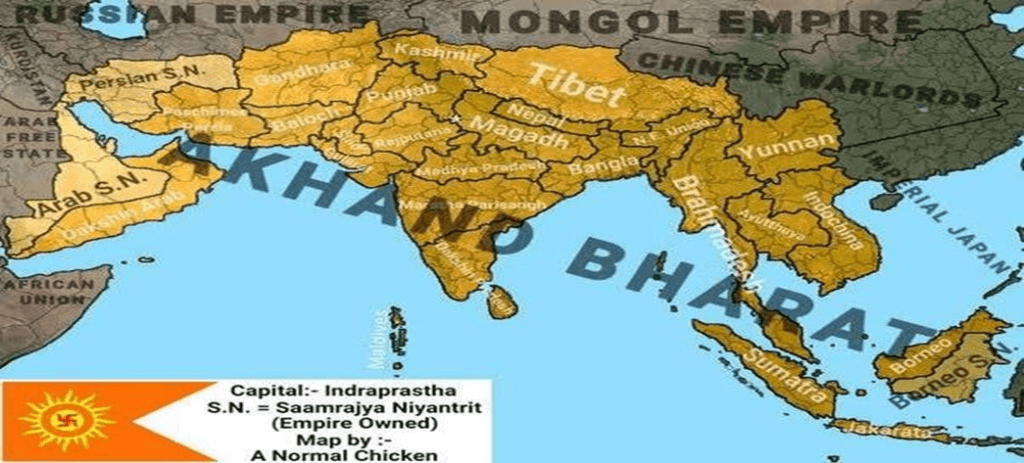The recently constructed Parliament building in India has garnered attention due to a striking mural depicting the map of ancient India. This mural showcases an undivided India known as Akhand Bharat, encompassing present-day Afghanistan, Pakistan, Maldives, Sri Lanka, Myanmar, Bangladesh, and India. However, objections have been raised by three neighboring countries—Pakistan, Nepal, and Bangladesh—regarding the inclusion of their territories in the map. In response, the Government of India has clarified that the map represents the ancient Ashokan Empire. This essay aims to shed light on the significance of this mural and the accompanying artifacts.
The Maski Edict
One of the notable features of the mural is the inclusion of an Ashokan rock edict from Maski, a town and archaeological site situated in Karnataka, India. This region gained prominence when C. Beadon discovered a minor rock edict of Emperor Ashoka in 1915. Unlike earlier edicts that referred to him as Devanampiye Piyadasi, this edict directly used the name Ashoka. Notably, all the edicts found on the Indian subcontinent under the name Devanampiye Piyadasi belonged to Emperor Ashoka. The Maski edict is etched on a rock-face in Durgada-gudda, one of the site’s gneissic outcrops.
The Sannati Sculpture of Ashoka
Another significant aspect of the mural is the portrayal of Ashoka through a sculpture found in Sannati, a village located on the banks of the Bhima River in Kalaburagi, Karnataka. The village gained prominence when the collapse of the Kali temple’s roof in the Chandralamba temple complex in 1986 revealed historically valuable Ashokan edicts written in Prakrit language and Brahmi script at the temple’s foundations.
This discovery led to the unearthing of the remarkable Maha Stupa at Kanaganahalli, referred to as Adholoka Maha-Chaitya (The Great Stupa of the Netherworlds) in the inscriptions. Furthermore, the sculpture-portrait of Ashoka seated on his throne with his queens, known as Raya Ashoka, was also found within the stupa. This finding provided new insights into Ashoka’s presence and influence in South India, although definitive proof of his sojourn in the region is still lacking.
The Government’s Clarification
In response to the objections raised by Pakistan, Nepal, and Bangladesh, the Government of India has clarified that the mural’s map represents the ancient Ashokan Empire rather than present-day territorial claims. The intent behind including this map is to showcase the historical significance and extent of the ancient empire. It serves as a visual representation of India’s rich heritage and cultural legacy, highlighting the expansive reach of Ashoka’s reign.
The Importance of Historical Artifacts
The inclusion of the Maski edict and the Sannati sculpture in the mural emphasizes the importance of historical artifacts in preserving and understanding India’s past. These artifacts provide valuable insights into Ashoka’s empire and his influence in different regions, including Karnataka. They offer glimpses into the language, script, and artistry of that era, contributing to our collective understanding of ancient India.

Important Points:
- The mural in the new Parliament building depicts the map of ancient India 🗺️
- It represents an undivided India known as Akhand Bharat, including present-day Afghanistan, Pakistan, Maldives, Sri Lanka, Myanmar, Bangladesh, and India 🇮🇳
- Pakistan, Nepal, and Bangladesh have objected to the inclusion of their territories in the map ❌🇵🇰🇳🇵🇧🇩
- The map is clarified to be of the ancient Ashokan Empire by the Government of India 🏛️
- The mural features the Ashokan rock edict from Maski, Karnataka 🪨
- Maski is an archaeological site where the edict was discovered in 1915 🚩
- The Maski edict is significant as it contains the name Ashoka, distinguishing it from earlier edicts 🧐
- The Sannati sculpture of Ashoka is also depicted in the mural 🖼️
- Sannati, located in Kalaburagi, Karnataka, gained prominence after the collapse of a temple roof in 1986 💥
- The collapse revealed valuable Ashokan edicts and the Maha Stupa at Kanaganahalli 🏰
- The sculpture-portrait of Ashoka, named Raya Ashoka, was found in the stupa 🕉️
- The discoveries shed light on Ashoka’s presence and influence in South India 🌞
- The Government clarifies that the mural represents historical significance, not present-day territorial claims 🗣️
- Historical artifacts like the Maski edict and Sannati sculpture contribute to understanding India’s past 🏺
- The inclusion of these artifacts showcases India’s rich heritage and cultural legacy 🌍
Why In News
The newly-built Parliament building proudly features a breathtaking mural showcasing the vibrant history of ancient India, where the intricate map serves as a captivating tribute to the rich cultural heritage of the land. Visitors are immersed in the awe-inspiring beauty of the mural as they are transported through time, gaining a deeper appreciation for the country’s remarkable past.
MCQs about Ancient India Map in the New Parliament Building
-
Which geographical area does the mural in the new Parliament building depict?
A. Present-day territorial boundaries of India
B. Map of ancient India (Akhand Bharat)
C. Map of South Asia
D. Historical landmarks of India
-
Which neighboring countries have objected to the mural?
A. Nepal, Bhutan, and Sri Lanka
B. Pakistan, Nepal, and Bangladesh
C. China, Myanmar, and Maldives
D. Afghanistan, Pakistan, and Bangladesh
-
What is the significance of the Maski edict?
A. It was the first edict of Emperor Ashoka found in India.
B. It contains the name Ashoka instead of Devanampiye Piyadasi.
C. It is etched on a rock-face in Sannati, Karnataka.
D. It reveals Ashoka’s presence in South India.
-
What do the artifacts in Sannati reveal about Ashoka?
A. His empire extended deep into South India.
B. Definitive proof of Ashoka’s sojourn in South India.
C. Ashoka’s interactions with neighboring countries.
D. The collapse of the Kali temple in Sannati.
Boost up your confidence by appearing our Weekly Current Affairs Multiple Choice Questions
![]()


